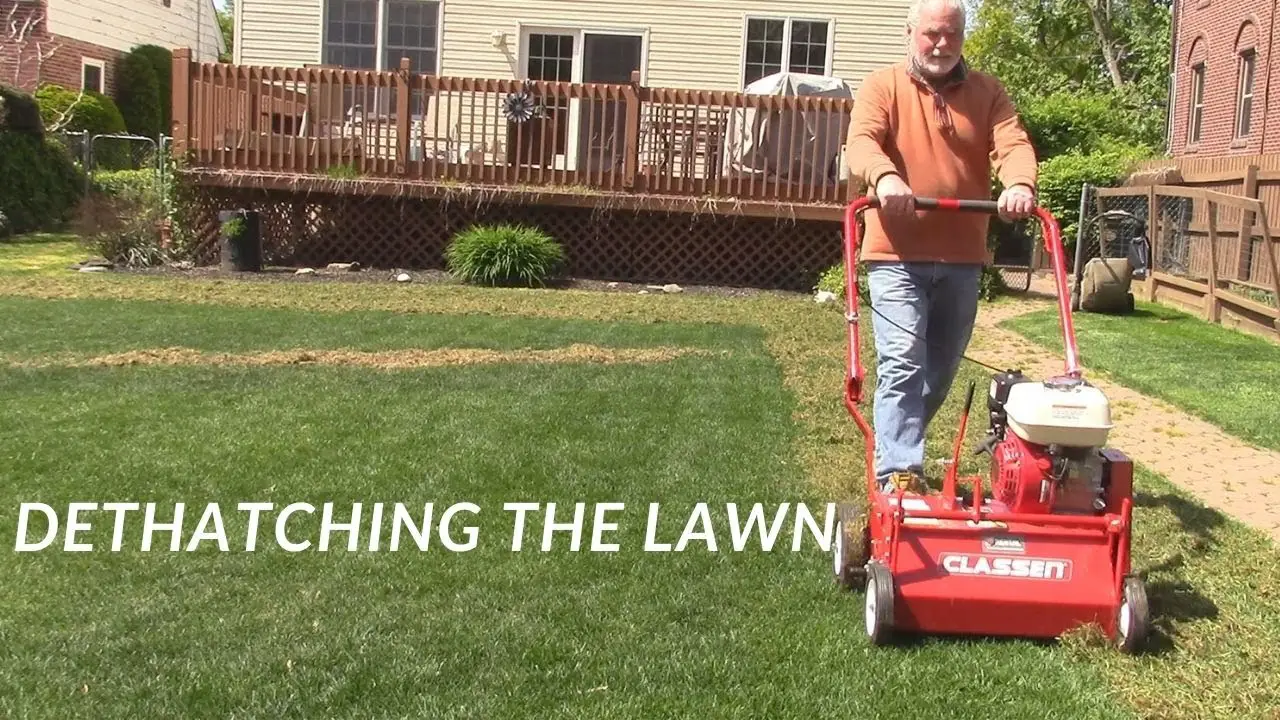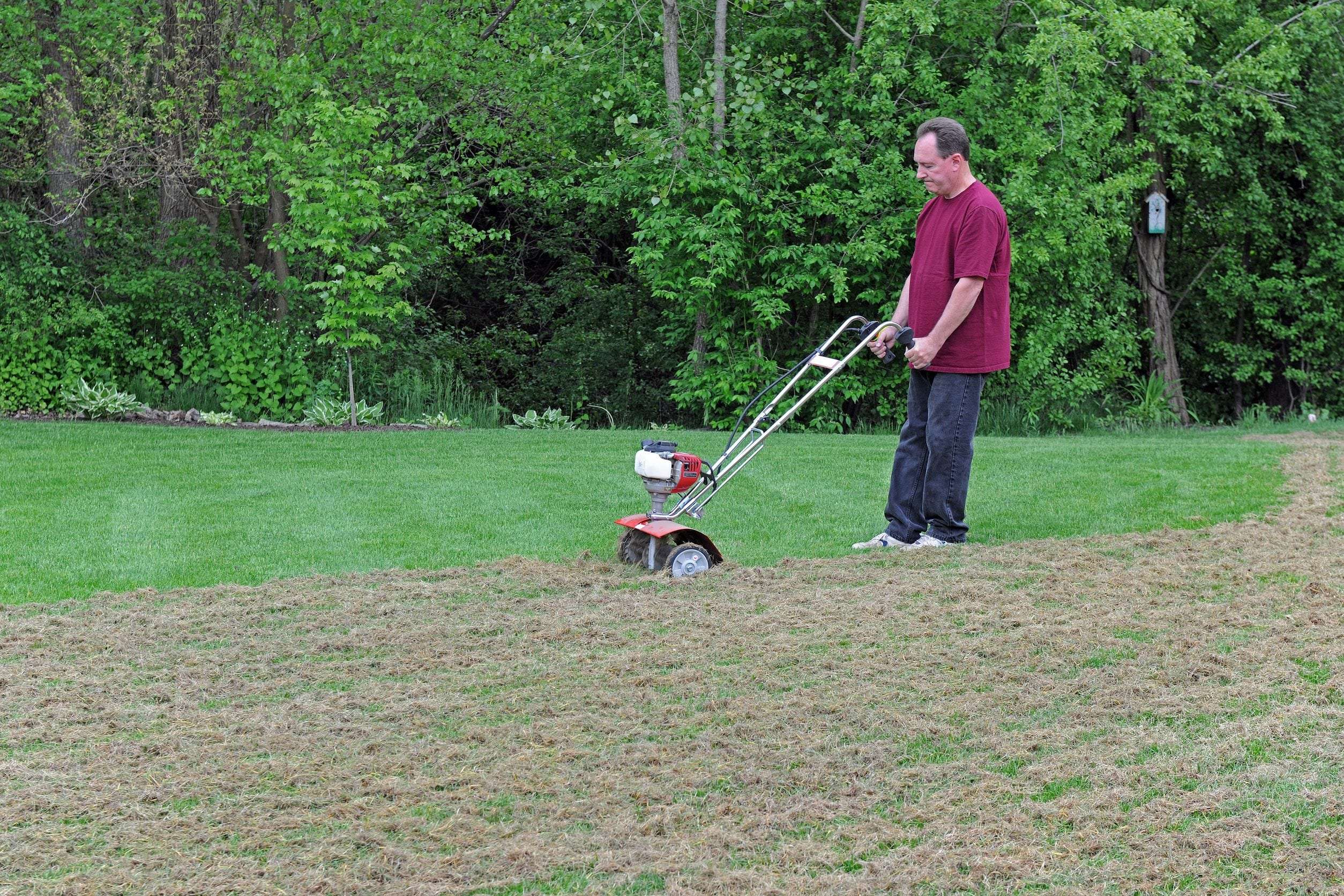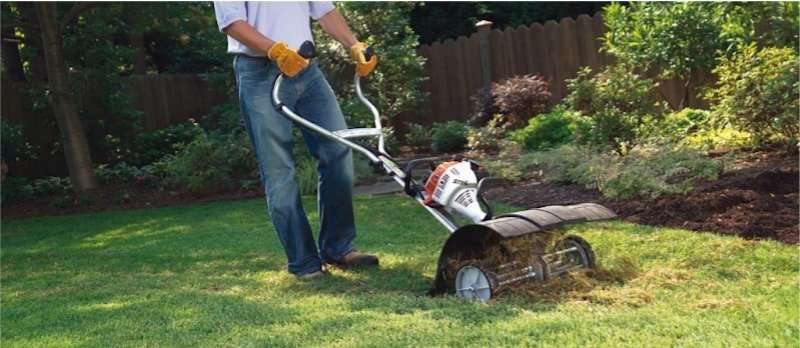When To Dethatch And Fertilize
You should dethatch your lawn as soon as its thatch layer becomes more than an inch thick. At this point, the thatch layer is usually so thick to a point where it becomes detrimental to the well-being of your lawn. A thick thatch layer will keep nutrients from reaching the grasss roots, it will make it harder for them to breathe, and it can also harbor harmful pests and diseases. Therefore, dethatching your lawn as soon as it starts becoming problematic which typically happens after every 5 years is always advisable.
As far as the season for dethatching is concerned, the best period is one that gives the grass the best chance of recovering. Ideally, you should dethatch right before the grass enters its rapid growth phase.
If you have warm-season grass on your lawn, the ideal period will fall either in early summer or late spring. However, if what you have is cool-season grass, then the best time to dethatch will be in late summer or during early fall.
As far as fertilization is concerned, it should be done right after dethatching. Doing so immediately after is important because of two reasons. The first is that it will provide the grass all the nutrients that it needs in order to recover at a faster rate. The second reason has to do with the fact that dethatching will make it easier for the fertilizer to reach the soil and hence giving it a better chance of reaching the soil and the roots of your grass.
Should I Water Lawn After Dethatching
Recovery After Dethatching Thatch removal can be traumatic for grass plants, so recovery techniques must encourage root repair and deep growth. Deep drenching with water rather than frequent shallow sprinkling helps attract root growth to lower levels where moisture persists longer than it does on the soils surface.
What Is Thatch And How Much Is Too Much
Over time, pieces of grass die and gather just above the soil, and these pieces are known as thatch, explains Scotts Miracle-Gro turf grass scientist Dr. Phil Dwyer.
In small amounts, thatch can actually help your lawn by insulating it from extreme temperatures, keeping much-needed moisture in the soil, and providing an extra layer of protection when your in-laws come over with their huge dogs .
Essentially, you will want to consider a dethatch if you notice your grass is struggling to grow, or if you have a half-inch or more of the stuff covering your lawn.
A half-inch or more of thatch can cause grass to suffer, because air, water, and nutrients arent able to move freely into and through the soil, and therefore, not reach the roots, Dwyer explains.
Keep in mind that sometimes, lawns will break down the accumulation of thatch naturally.
Lawns growing on good soil and that are properly fed may never have a thatch buildup, Dwyer says.
Thatch becomes a concern when the buildup happens too quickly.
Also Check: Average Cost Of Trugreen Lawn Service
What Is The Next Step After Dethatching Lawn
After dethatching, seed the lawn and consider topdressing. If youve taken plugs of soil, that soil can be left as a topdressing. But the planty thatch material should be removed. Callahan said the new areas opened by dethatching are a good opportunity to get some fresh seed and new turfgrass into your lawn.
Here Are Some Of My Favorite Lawn Care Products

Thanks a lot for making it to the end of this post! I hope you found it useful. Here are some lawn care products that I use and that I think youll also find helpful. These are affiliate links, so if you do decide to use any of them, Ill earn a commission.
In all honesty, these are some of the basic products that I use and recommend to everyone.
Also Check: How To Get Rid Of Clover In Lawn Without Chemicals
When Should You Dethatch Again
Your lawn needs to be dethatched once a year or whenever your thatch reaches a thickness of a ½ inch or so.
You can feel into the grass with your fingers to determine the thickness. Dethatching should be a regular part of your annual lawn maintenance to keep your grass lush and green throughout the year. You should plan to dethatch cool weather grasses in the late summer or early fall, and you can dethatch warm weather grasses in the spring after the green comes up.
Signs Your Lawn Needs Dethatching
So how to break up that dense layer of thatch without ripping your lawn to shreds? And how do you know when you need to?
You must dig down in your lawn and see what you have. With a trowel or other tool, dig out several patches. If you see a half-inch or more, consider dethatching.
Your lawn will likely exhibit other symptoms if it needs dethatching.
Signs of excess thatch include:
- Dry spots.
- Increased insect problems.
Dont remove thatch when the turf is weak or under stress, warns the Penn State Extension. That increases the chance youll injure the turf and decreases chances for its healthy recovery.
Don’t Miss: Troy-bilt Flex Mower Attachment For Sale
Lawn Thatch: What It Is And How To Deal With It
Lawn thatch is something which you need to control if you are to have a lush, healthy lawn.
Having some of it in your lawn is a good thing. However, too much can negatively affect the health of your lawn which often leads to other problems like moss invasions, weed takeovers and the onset of disease.
So what is lawn thatch? What causes it and how do you control it?
This article explains all.
Pros And Cons Of Leaf Blowers
The leaf blower is very quick when it comes to clean up but they require more muscle to handle than most of your other options. They will also require upkeep, either in the form of gas and oil or charging batteries.
Electric hand-held leaf blowers are the lightest, but weakest, while gas-powered backpack blowers are the heaviest and strongest of the leaf blower options.
For cleaning up thatch from your yard, you probably wont need something so heavy duty and pricey, but if youre doing it professionally, you might want to invest in a backpack model.
Read Also: Arbornomics Turfgrass
The Grass Becomes Weak And Sparse
Ordinarily, water carries oxygen and nutrients into the soil where they are consumed by the roots of the grass.
When there is too much thatch, those nutrients cant penetrate the soil and so the grass is starved of what it needs to produce food and grow.
As a result, it becomes weak and sparse.
Sometimes, the grass will grow roots into the thatch layer so it can consume the water and any nutrients which are held there. This makes the problem even worse.
Several Things Can Lead To Thatch Buildup
Some are related to the way you take care of the lawn, such as:
- Overfertilization
Others are more natural, like:
- Lack of the earthworms in the soil
- The properties of the plants themselves
For example, Kentucky Bluegrass has underground stems that are hard and take longer to break so instead of being cut down while mowing they remain and take part in thatch buildup.
Excessive thatch buildup wont just disappear by itself.When the layer reaches the worrying level, youll need to dethatch your lawn to allow your grass to preserve its health and continue growth.There are several ways you can go about this:
Recommended Reading: Does Big Lots Sell Lawn Mowers
Dethatching Vs Aerating Lawn
Aerating with a core aerator as opposed to dethatching may seem a preferable option to solving your thatch problems on paper, but theyre two completely different lawn care processes. Both procedures are geared towards creating healthy lawns and enhancing the breathability of the soil and the ability of the grass to soak up the essential nutrients, and promote root growth, but the two processes help your lawn in different ways.
Dethatching, as the name suggests, is the process of removing thatch from the soil surface. Thatch however does offer certain key benefits for your soil such as retaining soil moisture by acting as a mulch, providing a constant infusion of nutrients, as well as insulating the soil from temperature extremes.
Thatch only becomes a problem when the tightly intermingled layer is too thick, causing the grass roots to suffocate, thereby killing the healthy grass. Thatch that is too thick should be dethatched leaving only a healthy thin layer on the soil surface.
Lawn aeration is similar to dethatching in that it helps the soil under your lawn to breathe, but it is a procedure that helps control thatch rather than actually get rid of an excessive build up.
There are a range of manual lawn aerators available to help you with the aeration of small lawns. If you have a large grass area to aerate, then you will likely need a more substantial machine, there are many pull behind aerator tools available to you.
What Is Lawn Dethatching

Dethatching is the process of removing this layer of mostly dead stems, leaves and grass roots to replenish the soil with air, water, fertilizer, and essential nutrients.
Allowing thatch to accumulate reduces your lawns tolerance to drought, cold and heat stress, , and increases your turfs susceptibility to lawn diseases.
Thatch buildup in the worst cases restricts the grass roots from growing into the underlying soil, meaning they only take root in the all the thatch sitting on top of the soil.
However, dethatching or physical removal of thatch will not necessarily benefit all thatch plagued lawns, sometimes your lawn may just be lacking the beneficial microbes it needs to naturally dethatch or prevent thatching.
You May Like: Cost Of Trugreen Lawn Care
The Best Time To Dethatch
The period of active growth and warming temperatures of spring are ideal for dethatching, but exactly when in spring depends on the type of turf you have.
Both warm-season and cold-season turf types should be dethatched after they are actively growing. A general rule of thumb is to wait until they have been mowed a couple of times. For warm-season turf, this typically happens in late spring to early summer. For cold-season turf, the right time is usually early spring. Cold-season grasses can also be de-thatched in early fall while the grass is still growing, as it needs time to re-establish before the frost season.
Common warm-season grasses include Zoysia, St. Augustine, Bermuda, Bahia and Centipede. Common cold-season grasses include Kentucky bluegrass, rough bluegrass, fescue, and ryegrass.
What To Do After Dethatching The Lawn
As soon as youve finished, water the lawn and fertilize the turf. This is also a great time to overseed your lawn.
Introducing some premium seeds will help you revitalize your lawn and prevent future thatch buildup.
After a few weeks, depending on the weather conditions and the type of grass, the lawn should fully recover and youll be surprised how good and healthy it looks.
As for the debris youve collected, you can compost it for your garden, but only in the case that your lawn wasnt chemically treated or overflown with weeds.
Take steps to prevent future issues with excessive thatch. Water, fertilize, aerate, and mow your lawn regularly.
Mow at the height of about 2-3 inches so that air and water can freely flow and reach the thatch layer and speed up decomposition. Mulch lawn cuttings and fallen leaves to accelerate the development of good bacteria.
Check pH levels of the soil regularly and seek expert advice on what to use to balance it. Following these steps will help you nurture a green, lush, thick lawn that you can be proud of.
Don’t Miss: Commercial Lawn Care Prices
Scarify And Rake Your Lawn
Scarifying and raking physically removes thatch, dead foliage and moss from your lawn.
Scarifying is important as it removes thatch from around the base of the grass plants which allows are, water and nutrients back into the soil.
Raking controls the build-up of thatch by removing dead foliage and growth from the surface.
The best scarifiers often have changeable cartridges with vertical blades for dislodging thatch and spring tines for controlling thatch and moss from above the surface.
Its important that you choose the right time to scarify and this guide shows you how to scarify a lawn, step-by-step.
Should I Fertilize After Dethatching
Because you fertilize your yard immediately after dethatching, it is best to wait until your yard has greened up before applying nitrogen. If you fertilize while your grass is still dormant, you encourage weeds to compete with your grass. Too much nitrogen will exacerbate your thatch problem in the future.
Recommended Reading: How To Bring My Lawn Back To Life
Cleaning Up Reseeding After Dethatching
Whether you do it yourself or hire a professional, its a disruptive process to say the least, and your lawn is going to need a Band-Aid and some time to heal.
The first thing to do after dethatching is to remove the piles of thatch from your yard.
After dethatching, seed the lawn and consider topdressing. If youve taken plugs of soil, that soil can be left as a topdressing. But the planty thatch material should be removed.
Topdressing, he said, could give the existing root system a boost. It can also be a form of weed control, filling those gaps before weeds have a chance to take hold.
Within a month, you should see some results, Callahan said, depending on the weather.
Hot, dry weather could slow it down, but nice weather will get that new grass coming up uniform and vigorous in about a week, he said. In no time, it will look like a new lawn.
What To Do After Dethatching
After dethatching the lawn, use a leaf rake to rake up and remove the debris. Then water the lawn.
This is a good time to aerate your lawn. Aeration will create openings in the surface of the lawn that help water, air, and nutrients better penetrate the soil. This helps alleviate soil compaction, creates better air flow around the roots of the grass plants, and encourages the roots to grow more deeply.
To prevent future thatch problems, consider adding humate-rich, gypsum-based amendments to the soil. Jonathan Green MAG-I-CAL® Plus is a natural, humate-rich, three-in-one soil food that loosens hard soil, stimulates soil microbes, and adjusts soil pH. MAG-I-CAL® Plus is available for acidic soil and alkaline soil and should be used every season to keep your soil biology and chemistry balanced. It breaks up clay and compacted soil for better air, water, nutrient, and root penetration.
Visit Jonathan Green online or your nearest independent home and garden store for more information on when and how you should dethatch your lawn to reinvigorate it and keep it looking its best.
Don’t Miss: How To Make Lines In Lawn
How To Dethatch Your Lawn
Is It Better To Dethatch Or Aerate

Dethatching and aerating can both help keep a lawn healthy, but they do so in different ways. Dethatching needs to be carried out when the layer of thatch becomes too thick. A lawn that needs dethatching will feel very bouncy, but its best to dig down and remove a small section of grass and soil so you can measure the thatch layer before deciding to go ahead.
A lawn needs aerating, on the other hand, when the soil has become compacted. You may find thin or bare patches in the lawn, or the grass may be growing poorly. Gardening expert and writer Monty Don recommends doing so in September. Even if your lawn has come through this summer unscathed, it is always a good idea to aerate it at this time of year, he says on his site .
Don’t Miss: Lawn Mowing Advertising Ideas
Should You Fertilize After Dethatching
Yes, you should fertilize after dethatching. Your grass has not been able to receive the nutrients and water it needs, and you need to help it recover. Once you finish dethatching and watering your grass, you can fertilize.
You can use either a liquid quick release or a granule slow release fertilizer. Use a fertilizer that is rich in nitrogen in the spring and early summer, but as the winter approaches, you can change to one that is rich in phosphorus to prepare for the winter.
